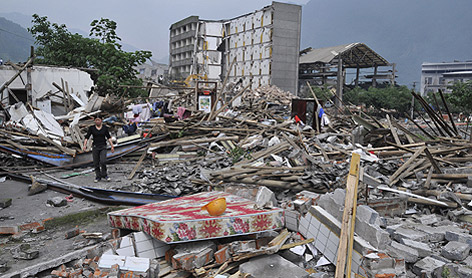Team developing new ‘intelligent’ textile that could help save lives.
15 Aug 2013

A team of University of Brighton researchers is developing a new ‘intelligent’ textile that could save lives by providing early warning of structural failure in earthquake zones.
Led by Dr Joan Farrer RCA, reader in Design and Materials at the Faculty of Arts, the team of cross-disciplinary researchers is developing a flexible textile membrane, which can be embedded into the skeleton structure and walls of buildings.
The Structural Health Monitoring System (SHMS) is designed to indicate the exact locality and extent of any damage to buildings via monitoring and analysis of electrical impulses generated by flexible, conductive nano-fibre polymers. The fibres link to an external monitoring computer, which assesses the movement and damage, as well as the feasibility and likely cost of repair. The prototype textile sensor could be used in new construction and retrofit projects in regions such as California, Turkey, China, Japan and New Zealand.
The research team, which won funding of over £31k in 2011 to undertake the research at the faculty of arts, comprises Kate Cheyne, Architecture and Kirsty McDougall Textiles, both senior lecturers mentored by Dr Farrer, and Professor Susannah Hagan, Professor of Urban Studies who made the successful bid to the university’s Research Challenge Scheme. The team also draws on the expertise of Maria Diakoumi, and Pierfrancesco Cacciola, senior lecturers at the School of Engineering Environment and Technology.
Initially, the conductive nano-polymer fibre was developed by Dr Emiliano Bilotti of the School of Engineering and Materials Science Queen Mary’s University London and their spinout company Nanoforce Technology Ltd., which is involved in the textile prototype testing. It also builds upon previous conductive textile work for health monitoring by Dr Farrer with Zephyr Technologies Ltd. in New Zealand, and is expected to position the university in the highly important field of earthquake research, which could lead to significant commercial collaborations.
The structural prototypes and supporting textile samples will be showcased as an interdisciplinary exemplar on the university’s Design Research Initiatives (DR-i) and Sustainability Network sites, and in exhibition form at Techtextil, Frankfurt, and Smart Material Network events, UK. A further planned bid for funding will incorporate field studies where the prototype materials will be tested in new buildings, and retrofitted to existing but unstable structures, to test the effectiveness of the reusable membrane and data collection.